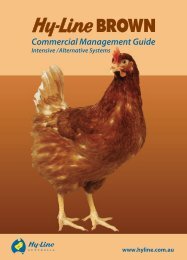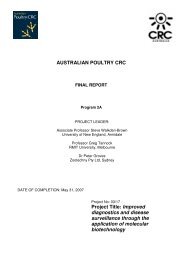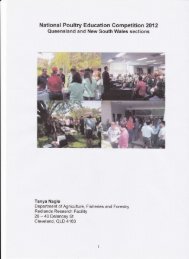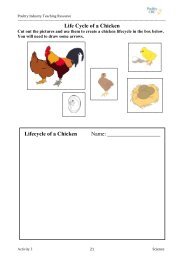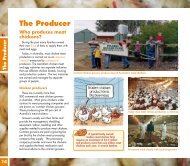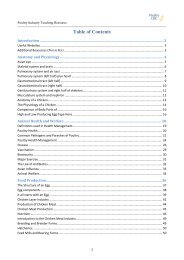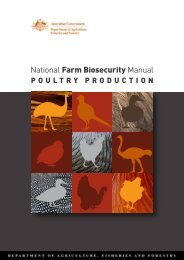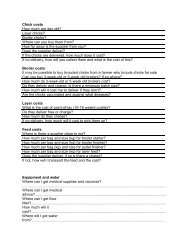You also want an ePaper? Increase the reach of your titles
YUMPU automatically turns print PDFs into web optimized ePapers that Google loves.
2.4.1 Experimental facilitiesThe birds were housed in two climate-controlled rooms for the brooder phase, and two temperaturecontrolled rooms for the grower phase. Birds were housed in their respective treatments groups from1 day of age until the end of the experiment. All analyses were conducted at the Department ofAnimal Science laboratories, located on the university campus.2.4.2 TreatmentsFour treatments were used in the experiment to test the stated hypotheses. The treatments consisted ofa 2 x 2 factorial, with grain type and particle size comprising the two factors. Within the grain typefactor, the two levels were wheat and sorghum, and within the particle size factor, the two levels werecoarse and fine particle size. The four treatments used were: Fine wheat (WF); Coarse wheat (WC);Fine sorghum (SF), and Coarse sorghum (SC).The diet formulations used were semi-purified, in an attempt to eliminate confounding factors in thediet, such as fibre. The diets were also free of antibiotic/growth promotant and coccidiostat, as theseadditives would most certainly affect the microbial ecology of the digestive tract.2.4.3 Feed preparationApproximately 50% of the wheat and sorghum used for the treatments was ground using a smallroller-mill (Wolf Engineering & Millwrights, Victoria, Australia) powered by a 0.75kW TecoElectrical and Machinery Company Ltd. (Taiwan) motor. Both rollers used, had approximately 2.75flutes.cm -1 , with flutes protruding from the roller by approximately 4 mm, and a 0.5 mm flattened top.The remaining grain was milled using a hammer-mill (JAS. Smith Pty. Ltd., Ballarat, Victoria,Australia), used for small scale grinding, operated at 2500 RPM (approximately 2000 kg.hr -1 capacity)and was powered by a 15kW (25.8A) (Australian Electrical Industries Pty. Ltd., Australia) motor.After milling, and prior to mixing with the remaining ingredients in a small rotary four-blade mixeroperated (at 23 RPM), each of the grains was sieved using a soil sieving machine (custom made forthe University of New England‟s School of Agronomy and Soil Science), vibrating at an approximateamplitude of 3 cm at a frequency of approximately 20 Hz, fitted with a 2.0 mm sieving screen.Screenings collected from under the sieve were used for the „fine‟ treatments, and residue on the top ofthe screen was used for the „coarse‟ treatments.Celite ® was added as a source of acid insoluble ash, as an indigestible marker for nutrient digestibilityanalyses. Cellulose was added to the sorghum diet to serve as an energy diluent, whilst semi-purewheat starch (Fielder‟s Wheaten Corn Flour) was added to the wheat diet to increase themetabolisable energy content.All diets were “cold” pelleted using a 7.5 kW Templewood Hawkesley (Slough, Bucks, England) coldpelleter fitted with a 4.0 mm die, moving at 126 RPM past two pellet cutter blades. The mean pelletlength for all diets was approximately 6mm. The actual feeding trial was conducted as described insection 2.4.1.2.5 Experiment ThreeThe third experiment was held under commercial conditions on rice husk litter to give a „real world‟perspective to the body of research, as Experiments One and Two were conducted under experimentalconditions in cages.The experiment was conducted at the Bartter Enterprises Pty. Ltd. grow-out testing facility, locatednear Hanwood in southern central New South Wales (34.33˚S, 146.03˚E) at an elevation of11



